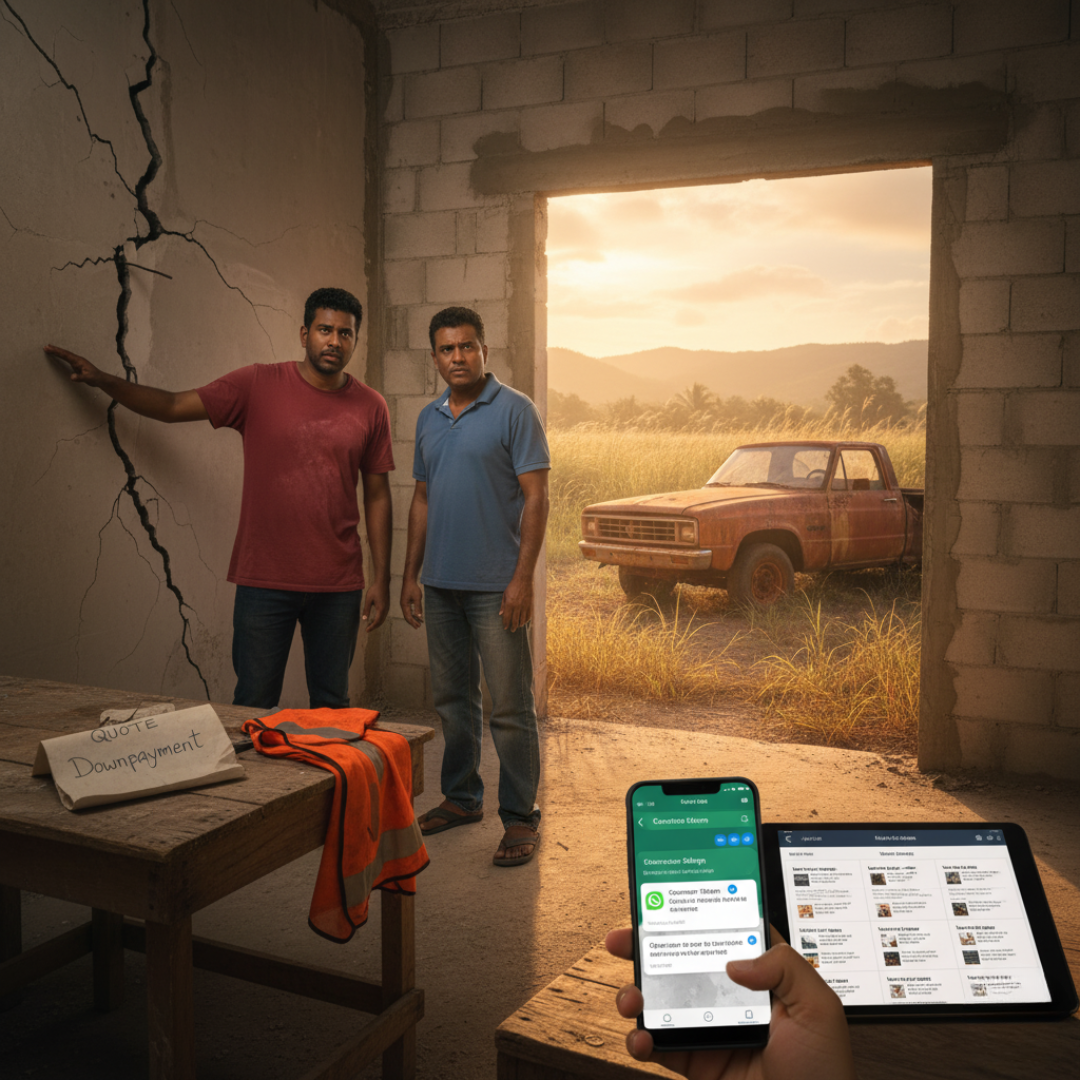Planning Permission Trinidad 2025 Guide | DevelopTT & TCPD Explained
The 2025 Guide to Planning Permission in Trinidad & Tobago
Updated: October 2025
DevelopTT Made Simple
Somewhere in Couva, a man is standing over a half-built foundation, hands on his hips, shaking his head. The neighbour across the street calls out, “Yuh get permission yet?” He gives a sheepish laugh. “Soon come.”
That “soon come” has cost more money, time, and sleep than cement.
If you’ve ever tried to build or extend a house in Trinidad & Tobago, you already know the legend of Town & Country Planning. For years, getting approval felt like trying to find doubles at midnight — plenty talk, little direction. But since the arrival of DevelopTT, things have changed. Slowly, quietly, but for the better.
This guide will walk you through how the system really works in 2025, how to apply properly, what to expect, and how to avoid the headaches that trap so many first-time builders.
What Planning Permission Really Means
Every house, apartment, shop, or subdivision in Trinidad & Tobago sits under the Town and Country Planning Act, Chapter 35:01. That law says you cannot start “development” without permission. Development includes any new building, major renovation, or change of land use — even converting a garage to a mini-mart.
It’s not red tape for the sake of it. The approval protects you. It ensures your home is built safely, fits the area’s land-use policy, and won’t end up blocking a drain, road reserve, or someone else’s light and air.
You apply through the Town and Country Planning Division (TCPD), which operates under the Ministry of Planning and Development. There are two main types of permission:
- Outline Permission – This checks whether your proposal fits zoning and policy. It does not approve drawings yet.
- Final Permission – This is full approval of your building plans. Once granted, you can move forward to your Municipal Corporation for a Provisional Permit and start construction.
The Shift to DevelopTT
Most applications now go through DevelopTT, the national online portal for planning and development approvals. The site lets you register, upload drawings and documents, track your application in real time, and receive updates directly in your dashboard. The Public Application Register also lets anyone check the status of an application by name or reference number.
There is no TCPD fee for planning permission right now. Municipal Corporations charge their own fees for building permits and related services.
Online submission via DevelopTT is the standard. Regional operations rolled out in phases, so always confirm current requirements with your local office.
What You Need Before You Start
Before you even open the portal, assemble your documents. Missing items are the number one reason applications get delayed.
For Outline Permission:
- Completed TCPD forms (available within the portal)
- Recent cadastral or survey plan showing plot boundaries
- Location sketch and basic site layout
- Ownership documents (Deed or Letter of Authorization)
- Statement of intended use (for example, “single family dwelling”)
For Final Permission:
- Architectural drawings (site plan, floor plans, elevations, sections)
- Topographic survey (for sloping land)
- Drainage plan and connection points
- Structural details
- Copies of any earlier Outline Permission letters
All drawings must be prepared and stamped by a qualified draughtsman, architect, or engineer. If you’re not sure who to hire, find verified professionals on Ahlookin who can prepare and submit your plans correctly the first time.
Step-by-Step: How to Apply on DevelopTT
Step 1: Register and Log In
Visit developtt.gov.tt and create an account using TTConnect credentials. Verify via email before logging in.
Step 2: Start a New Application
Choose whether you’re applying for Outline or Final Permission. Fill in property details exactly as they appear on your deed or cadastral sheet.
Step 3: Upload Your Documents
Attach drawings and ownership documents in PDF or image format. The portal validates uploads to prevent missing items.
Step 4: Submit and Track
After submission, you’ll receive an application reference number. Track progress in your dashboard or through the Public Application Register.
Step 5: Respond to Queries
If TCPD requests more information, you’ll get a notification. Upload corrected files directly. Respond quickly — most delays come from slow replies, not slow officers.
Step 6: Receive the Decision
When approved, you’ll receive a Final or Conditional Permission Letter through the portal. Save this file; it’s your key to move on to your Municipal Corporation.
After TCPD Approval: What Happens Next
Planning permission alone does not allow you to start building. You must now approach your Municipal Corporation for a Provisional Building Permit.
- The Corporation’s Building Inspectorate checks structural integrity, drainage, and sewer connections.
- You may need clearance from WASA, Fire Service, or the Environmental Management Authority (EMA) depending on the project type.
Once the Provisional Permit is granted, you can begin construction. Inspectors will visit during and after the build, and a Completion Certificate is issued when everything passes inspection.
Common Pitfalls and How to Avoid Them
- Missing documents. Use the official checklist before submitting.
- Mismatched information. Lot numbers on your plan must match your deed exactly.
- Outdated drawings. Using old subdivision layouts or unapproved plot numbers leads to rejection.
- Ignoring conditions. If Outline Permission required changes, reflect them in your Final submission.
- Starting work without approval. Building without permission can trigger demolition orders and loss of future approvals.
What If Your Application Is Refused
If refused, you can:
- Request a review through the Advisory Town Planning Panel (ATPP).
- Appeal to the Minister of Planning within 28 days.
- Re-submit corrected drawings addressing the refusal points.
Regional Variations
While DevelopTT is national, each regional office has its quirks. Some smaller projects may still be processed manually. Confirm current procedures with your regional TCPD office before visiting.
Enforcement: What Not to Do
Unauthorized development is taken seriously. If you build without permission or deviate from approved plans, TCPD can order alteration or demolition, refuse Completion Certificates, or block future applications. The safest approach is to get it right from the start.
How Ahlookin Fits In
Navigating the system is easier when you have the right people on your side. On Ahlookin, you can:
- Find certified draughtsmen, architects, and engineers who know the DevelopTT process.
- Post a job describing your project and get verified quotes.
- Browse deals on design and planning services.
- Download free TCPD submission checklists.
Ahlookin isn’t another website with generic advice. It’s a real hub built for Trinbagonians by Trinbagonians — a place where professionals and homeowners meet to get things done properly.
Quick Checklist Before You Apply
- Confirm zoning and land-use category.
- Gather deed or authorization letter.
- Get updated survey or cadastral plan.
- Prepare drawings from a certified professional.
- Register on DevelopTT.
- Complete application and upload documents.
- Track and respond to queries.
- Collect Final Permission letter.
- Apply for Provisional Permit at Municipal Corporation.
- Keep copies of all approvals and certificates.
Closing Thoughts
The system isn’t perfect yet, but it’s miles ahead of what it used to be. The paper chase is shrinking, and more homeowners are learning how to play by the rules without losing months of their life.
If you’re ready to build, start smart. Follow the process. Get your approvals right the first time. And when you’re ready for professionals who can make it happen, you already know where to find them.
Visit Ahlookin.com — real people, real jobs, real help.
.png)





